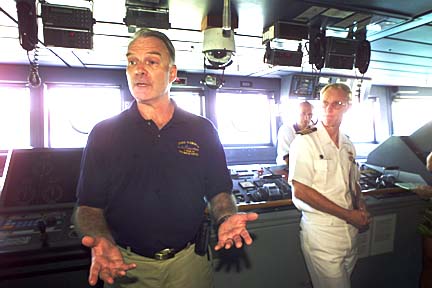


Sea conditions, The Navy says the two biggest factors leading to the success of the recovery of the sunken Ehime Maru will be engineering and environmental issues such as tides, weather patterns, ocean topography and currents.
engineering affect
recovery of
Ehime Maru
The USNS Sumner has gathered
data since June on the area
near the sunken shipBy Gregg K. Kakesako
gkakesako@starbulletin.com"We can be operationally ready at the sound of the gun, but if the weather isn't right, we have to hold (until the weather improves)," said Rear Adm. William Klemm, who is coordinating the recovery.
Ocean current analyses and weather forecasts also will help the Navy determine where to place oil containment booms and skimmers, should any of the 45,000 gallons of lube oil and diesel fuel believed to be on the ship leak when the vessel is lifted and moved.
Since late June the USNS Sumner, a 328-foot oceanographic survey ship operated by the Military Sealift Command, has been surveying the bottom of the ocean from Waikiki to the entrance of Pearl Harbor.
The Sumner's scientific crew has undertaken a bathymetric survey needed to create detailed charts of the sea floor. The scientists also deployed special meters and buoys to measure currents and weather. Sea floor core samples were collected at both the deep-water and shallow-water recovery sites to help engineers determine how to lift the Ehime Maru and where to place it.
The Ehime Maru sank Feb. 9 after colliding with the U.S. nuclear submarine USS Greeneville nine miles south of Diamond Head. The Navy wants to relocate it to shallower waters, about 115 feet deep, a mile south of Honolulu International Airport's reef runway.
The Sumner's crew has compiled extensive bathymetric data in the area.
On Wednesday the heavy-lift vessel Rockwater 2 began drilling under the Ehime Maru, placing the cables that eventually will be used to lift the Japanese vessel off the seabed. Once 90 feet off the bottom, the Ehime Maru will be moved in daylight to the reef runway recovery site, 12.5 miles away.
There, Navy and Japanese divers will search the vessel for the bodies of the nine crewmen believed to be entombed in the ship. The Navy believes there is an 80 percent chance that the unprecedented $40 million operation will be successful, but it doubts whether all nine of the missing men and boys will be found.
In Japan yesterday, U.S. Navy officers provided details of the salvaging operation to relatives of those lost in the vessel's sinking.
The officers, led by Rear Adm. Robert Chaplin, met the relatives in Uwajima, Ehime prefecture, in western Japan. The sunken ship belonged to Uwajima Fisheries High School in Uwajima, and many of the nine missing people were from the area.
After the briefing, Ryosuke Terata, the 45-year-old father of Yusuke, who was 17 when he was lost, said he wants to recover even a small piece of his son's clothes.
At the Hawaii briefing, Capt. William Aldinger, Pacific Fleet oceanographer, said he does not think there will be problem until the Rockwater 2, with Ehime Maru in tow, reaches the "wall," or the reef shelf, about a mile from the shallow-water recovery site.
From there the Ehime Maru will have to be lifted more than 1,500 feet up a steep wall in a short period of time, said Michael Caron, chief scientist with the Naval Oceanographic Office at the Stennis Space Center in Mississippi.
Caron said the Sumner, with its team of 15 scientists, was to leave Aloha Tower's Pier 9 today to spend more time surveying the "wall" area.
The Navy's plans call for the Ehime Maru's lift operations to begin near the end of the month.
The Rockwater 2 is expected to take three to four days to travel the 12.5 miles, traveling at 1 knot per hour, moving almost in a straight line in a northwesterly direction over fairly level ocean floor and pausing when it reaches the "wall." Favorable tide and weather conditions will determine when the Rockwater 2 will begin this final leg.
At the shallow-water site, the Navy plans to let the Ehime Maru rest for 48 hours to ensure the ship is firmly on the bottom before sending the first team of divers into its hull.
Caron said the ocean bottom where the Ehime Maru sank is silt and sand over a clay surface.
Aldinger said there is a mixed tide system around the entire Hawaiian chain, and Oahu experiences two high tides and two low tides each day.
It will be Sumner's job, Aldinger said, to lead the Rockwater to the shallow-water recovery site, measuring the currents and relaying that information to the on-scene commander to ensure he does not exceed safety standards.
Currently, the Ehime Maru operations command center receives a weather update every two days. Those updates will increase to one every six hours once the decision has been made to begin the lift operations, said Lt. Ken Ingram, meteorological officer with the Naval Pacific Meteorological and Oceanography Center.
Caron said the Navy now can comfortably predict the weather three days in advance.
As for the ever-present tradewinds, Ingram said they affect the wind-driven surface currents around the shallow-water site.
The most favorable conditions would be tradewinds from east to northeast.
"Because tradewinds are here almost all of the time, it's the variance in strength that could hamper the operation," he said.
A strong pulse in the trades may cause rough seas that could cause problems.
Kyodo News Service contributed to this report.